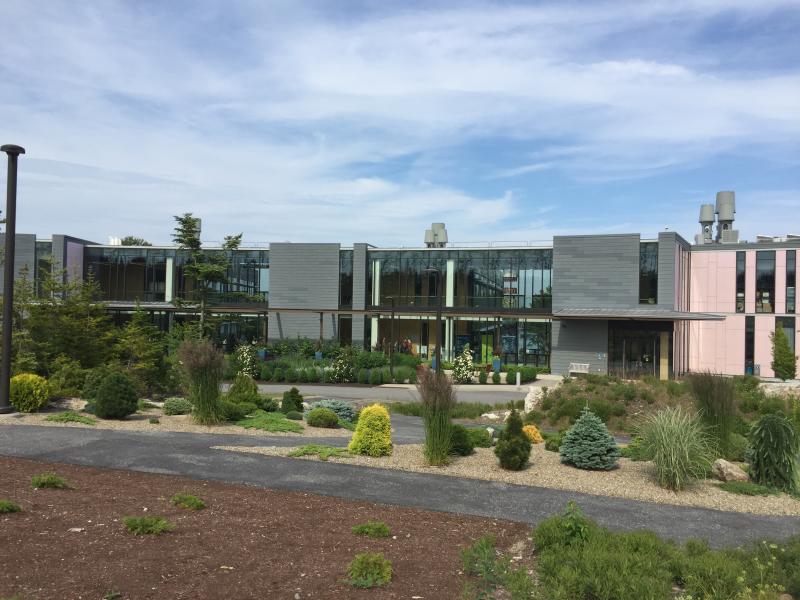Bigelow Laboratory for Ocean Sciences opened its doors to the public on July 1 for a tour of several of its research facilities. About 100 individuals had indicated they would attend, according to Dana Wilson, communications director for the lab.
Bigelow works primarily with the ocean microbiome, that is, microscopic organisms in the oceans. According to the tour guides, most of the organisms in the oceans are not yet described — that is, most do not yet even have a scientific name. Little is known about the properties of most of the organisms in the ocean, and this provides a great deal of fodder for research — and also for possible commercial exploitation.
The lab was named after the founder of Woods Hole Oceanographic Institute on Cape Cod. It is celebrating its 42nd year this week. The lab moved from a small facility on McKown Road in West Boothbay Harbor several years ago to a sprawling new campus in East Boothbay, with a grant from the Maine Technology Institute and a matching anonymous grant, and continues to expand. A new greenhouse for growing algae, and a new residence hall for visiting scientists, post docs, and interns are both currently under construction at the site.
In addition to the work on site, there are also dozens of field missions ongoing at any given time, taking water samples and collecting sea plant and animal samples.
The lab has 16 senior research scientists and a bevy of undergraduate interns and post docs who work with them. For this tour, four labs were open to the public, including a deep ocean research center studying bacteria that live on iron, rather than light or biological organisms. Dave Emerson, the senior research scientist involved with that project, said the deep ocean organisms are difficult to study, requiring the use of manned and unmanned submersible devices. His organisms are found at hydrothermal vents at sea mounts or at mid–ocean ridges and deepwater trenches, where they use the energy of the planet to sustain themselves. Many of them cannot tolerate oxygen, and therefore, can’t live close to photosynthetic bacteria and plankton that live near the surface.
Other labs visited included a lab studying the effect of ocean acidification and warming on slightly larger organisms — in this case, young lobsters. By the end of the century, it is expected that carbon in the atmosphere will be at 1200 parts per million, and a lot of it will dissolve in the oceans, causing them to acidify. This process is already under way, but will become stronger by the end of the century. The oceans are also expected to warm up significantly, according to the researchers. The students raised juvenile lobsters under various conditions of acidic ocean water and increased temperatures.
Another lab looked at the changes taking place in the Gulf of Maine with the upper layer of water and the amount of plankton present in the water. Using “gliders” that slowly traverse the Gulf, images from satellites, and manual transits across the Gulf, this year on the Cat ferry, the researchers are looking at decreasing plankton, caused mostly by increased fresh water from snow runoff and ice melt entering the Gulf. Researchers say that the decrease is making the Gulf less productive over time, but much more information is needed to identify what is happening long term. Researchers say that the gulf’s biome may change, making it less attractive to lobster and other cold-water species. Cold fresh water may also be acting as a cap over warmer salt water, preventing upwelling that brings nutrients to the surface. More ominously, there have been minor changes to the position of the Gulf Stream, which keeps New England and northern Europe at a moderate temperature because of the colder surface water.
Much of what Bigelow does is pure science, but there are also applied sciences that find a home at the laboratory. Identifying new potential in ocean organisms for commercial growth is also a part of the mission. Studies currently under way to determine how plankton and other ocean photosynthetic organisms might be used in new fuel or food sources are major focuses. The lab also studies how blooms of certain zooplankton and other organisms can cause problems for various industries, such as the shellfish industry, as part of a joint effort by various departments of marine resources and the lab.
The Bigelow Laboratory is also a teaching institution, and works with students from juniors in high school, through its Keller BLOOM program, through college programs. It has a relationship with Colby College, and several of its instructors teach at the college and invite students to come down as interns. Its undergraduate program is competitive, providing students with paid learning experiences for ten weeks each summer.
Bigelow also offers a lecture program given by its scientists through its Cafe Scientifique program each year. For information on this year’s program, visit https://www.bigelow.org/news/welcome-bigelow-laboratory-s-cafe-scientifi....





























